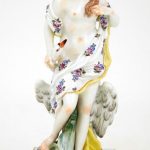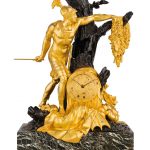In Greek mythology, the swan was a bird consecrated to Apollo, and it was therefore considered a symbol of harmony and beauty and its limited capabilities as a singer were sublimated to those of songbirds.
The swan also plays a part in the story of Leda and the Swan in which the god Zeus (Jupiter in Roman mythology), ieduces (or in some versions, rapes) Leda in the guise of a swan. According to later Greek mythology, Leda bore Helen and Polydeuces, children of Zeus, while at the same time bearing Castor and Clytemnestra, children of her husband Tyndareus, the King of Sparta. In the W. B. Yeats version, it is subtly suggested that Clytemnestra, although being the daughter of Tyndareus, has somehow been traumatized by what the swan has done to her mother (see below). According to many versions of the story, Zeus took the form of a swan and seduced Leda on the same night she slept with her husband King Tyndareus. In some versions, she laid two eggs from which the children hatched. In other versions, Helen is a daughter of Nemesis, the goddess who personified the disaster that awaited those suffering from the pride of Hubris. Reference: Wikipedia
The swan is also associated with Etruscan mythology, in particular with the Etruscan goddess of Love, Turan. Turan was commonly associated with birds such as the dove, goose and above all the swan.
Leda and the swan. Leda is entwined with Jupiter, disguised as a swan, with a large egg at lower right; after Michelangelo Engraving Print made by: Cornelis Bos After: Michelangelo biography
Reference: © The Trustees of the British Museum
HANS SEBALD BEHAM (1500-1550) Leda and the Swan engraving, 1548, on laid paper, without watermark, a very good impression of the second state (of three), with margins, in very good condition Plate 46 x 59 mm., Sheet 55 x 68 mm.
Sold for GBP 1,750 at Christie’s in 2019
Meissen Porcelain Figure of a Maiden with Swan 20th century Height 10 inches.
Sold for $156 (includes buyer’s premium) at Doyle in 2020
AN 18TH CENTURY ITALIAN SCAGLIOLA PANEL
The depiction of a winged figure driving swans from within a chariot, the scagliola panel framed in thick black slate. A piece of paper verso from an unknown source offers provenance for this piece. The scagliola technique originated in Italy in the 17th-century and served as a substitute for the more difficult and expensive pietra dura and mosaic inlay decorative techniques.
Sold for $475 at Soulis Auctions in 2020
During the classical and Hellenistic periods, Etruscan craftsmen excelled in the production of bronze mirrors decorated with mythological scenes. This example depicts Turan (Aphrodite), identified by an inscription, riding a swan while making the gesture of anakalypsis (unveiling). This subject, which was particularly appropriate for items of toiletry, appeared first in Greece in the fifth century BCE, and was successfully revived in Etruria in the fourth century.
The subject depicted on this mirror is particularly suitable both for its function and for the circular surface to which the craftsman was restricted. The disc is framed by a garland of laurel leaves. The medallion in the center features the goddess Turan, the Etruscan Aphrodite, identified in inscription (which reads from right to left) near the young woman’s face. The goddess rides a swan, one of her customary companions. With wings outspread, the bird holds a branch in its beak. Turan winds her left arm round the swan’s neck, while with her right hand she draws aside a panel of her garment, as though unveiling herself (in Greek, the gesture of ‘anakalypsis’).
Reference:The Louvre
Wall painting fragment with a swan ca. A.D. 14–68 Roman
Reference: The Metropolitan Museum of Art








